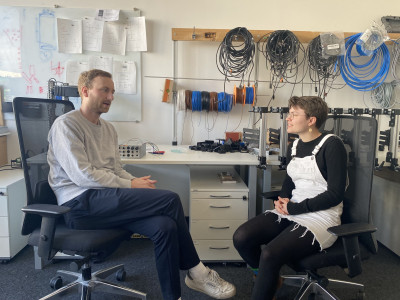Why invest in AI for quality control? - A sample calculation.
Episode 6
Author: Hanna Nennewitz
Why invest in AI for quality control? - A sample calculation.
Episode 6
Author: Hanna Nennewitz

In the last episode, Peter Droege, CEO and co-founder of Maddox AI, explained what the biggest problems of visual quality control are in the industry. The insight was that AI-based systems are a good option to address these issues. But what about finances? Is it even worth investing in an AI-based system? These are the questions I turn to in this episode. Once again, Peter Droege can give me the answers to these questions.
Peter explains in our conversation that there are five financial levers that can be turned with the help of AI-based systems, such as the Maddox AI system. The levers are as follows:
- saving personnel costs,
- minimizing returns / complaints,
- increasing traceability,
- preventing excessive scrap rates in production and
- process improvements.
1. Personnel Costs
2. Minimization of Complaints & Returns
 Returns in connection with the necessary re-sorting actions can quickly become very expensive. Alongside this, incorrectly shipped parts are bad for customer relations. With an AI-based system in visual quality control, the likelihood of receiving returns can be significantly reduced. This is mainly because an AI-based system inspects more accurately and consistently than a human. One Maddox AI customer received two complaints in the year before the Maddox AI system was installed. The complaints and re-sorting work alone generated costs of a quarter of a million euros. Since the installation of Maddox AI and the resulting optimized control of the parts, our customer has received no further complaints, which saves relevant costs.
Returns in connection with the necessary re-sorting actions can quickly become very expensive. Alongside this, incorrectly shipped parts are bad for customer relations. With an AI-based system in visual quality control, the likelihood of receiving returns can be significantly reduced. This is mainly because an AI-based system inspects more accurately and consistently than a human. One Maddox AI customer received two complaints in the year before the Maddox AI system was installed. The complaints and re-sorting work alone generated costs of a quarter of a million euros. Since the installation of Maddox AI and the resulting optimized control of the parts, our customer has received no further complaints, which saves relevant costs.
Peter tells me about another customer who manufactures tractors, some of which are highly customized. The tractors are shipped all over the world. Before the installation of Maddox AI, a wrong configuration in the production in Germany was not noticed from time to time. If the tractor was then shipped to the USA, for example, and the incorrect configuration was only noticed there on site, it was very costly to correct this error. Since the manual inspectors have been supported by the Maddox AI system, the number of customer complaints has been significantly reduced. Each saved error usually directly saves a five-digit amount.
3. Traceability
However, should a return occur despite AI-based quality control, Maddox AI customers also have the advantage that each part can be individually tracked. “For example, if I have a serial number or a QR code, I can track a part one-to-one. If a complaint does occur, I can use an image to prove that the disputed part left the factory without defects,” Peter explains. The documentation therefore offers further protection against high reclamation costs.
4. Preventing Excessive Scrap Production
5. Process Improvement
Usability - Can I also Operate Maddox AI?
Episode 7

In this episode, Hanna Nennewitz tests the usability of Maddox AI by trying to create a quality control model by herself. In comparison, she tries to programme the same testing task with a rule-based system.
Read the article